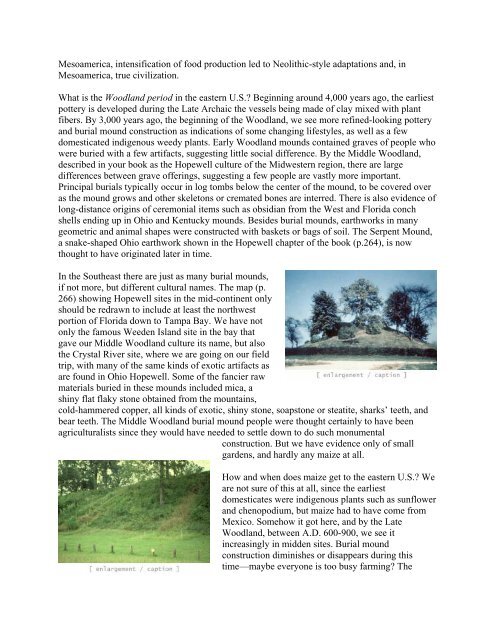INTRODUCTION TO ARCHAEOLOGY Nancy White - Touro Institute
INTRODUCTION TO ARCHAEOLOGY Nancy White - Touro Institute
INTRODUCTION TO ARCHAEOLOGY Nancy White - Touro Institute
Create successful ePaper yourself
Turn your PDF publications into a flip-book with our unique Google optimized e-Paper software.
Mesoamerica, intensification of food production led to Neolithic-style adaptations and, in<br />
Mesoamerica, true civilization.<br />
What is the Woodland period in the eastern U.S.? Beginning around 4,000 years ago, the earliest<br />
pottery is developed during the Late Archaic the vessels being made of clay mixed with plant<br />
fibers. By 3,000 years ago, the beginning of the Woodland, we see more refined-looking pottery<br />
and burial mound construction as indications of some changing lifestyles, as well as a few<br />
domesticated indigenous weedy plants. Early Woodland mounds contained graves of people who<br />
were buried with a few artifacts, suggesting little social difference. By the Middle Woodland,<br />
described in your book as the Hopewell culture of the Midwestern region, there are large<br />
differences between grave offerings, suggesting a few people are vastly more important.<br />
Principal burials typically occur in log tombs below the center of the mound, to be covered over<br />
as the mound grows and other skeletons or cremated bones are interred. There is also evidence of<br />
long-distance origins of ceremonial items such as obsidian from the West and Florida conch<br />
shells ending up in Ohio and Kentucky mounds. Besides burial mounds, earthworks in many<br />
geometric and animal shapes were constructed with baskets or bags of soil. The Serpent Mound,<br />
a snake-shaped Ohio earthwork shown in the Hopewell chapter of the book (p.264), is now<br />
thought to have originated later in time.<br />
In the Southeast there are just as many burial mounds,<br />
if not more, but different cultural names. The map (p.<br />
266) showing Hopewell sites in the mid-continent only<br />
should be redrawn to include at least the northwest<br />
portion of Florida down to Tampa Bay. We have not<br />
only the famous Weeden Island site in the bay that<br />
gave our Middle Woodland culture its name, but also<br />
the Crystal River site, where we are going on our field<br />
trip, with many of the same kinds of exotic artifacts as<br />
are found in Ohio Hopewell. Some of the fancier raw<br />
materials buried in these mounds included mica, a<br />
shiny flat flaky stone obtained from the mountains,<br />
cold-hammered copper, all kinds of exotic, shiny stone, soapstone or steatite, sharks’ teeth, and<br />
bear teeth. The Middle Woodland burial mound people were thought certainly to have been<br />
agriculturalists since they would have needed to settle down to do such monumental<br />
construction. But we have evidence only of small<br />
gardens, and hardly any maize at all.<br />
How and when does maize get to the eastern U.S.? We<br />
are not sure of this at all, since the earliest<br />
domesticates were indigenous plants such as sunflower<br />
and chenopodium, but maize had to have come from<br />
Mexico. Somehow it got here, and by the Late<br />
Woodland, between A.D. 600-900, we see it<br />
increasingly in midden sites. Burial mound<br />
construction diminishes or disappears during this<br />
time—maybe everyone is too busy farming? The
















